5 Predictions About the Future of B2B Content Marketing
We interviewed the former Director of Content at Intercom to unpack the data from a recent OGM report about the future of B2B Content Marketing. Here are his predictions and insights for your next strategy planning session.

Content marketing is in the middle of a pretty serious shake-up.
To help navigate the massive shifts coming (and already happening), we’re tapping long-time content leaders to bring you their expertise and insights on the future of content marketing.
Our first conversation is with John Collins, former marketing leader at Intercom and Ramp, who recently co-produced a report with Nigel Stevens and the team at the Organic Growth Marketing Agency (OGM) based on survey data from B2B software buyers.
The report adds much-needed evidence to some of the trends content marketers are seeing in the space. It also challenges a few popular narratives and, like all good industry data, prompts the reader to ask thoughtful questions about where things are headed next.
If we are sitting at a crossroads for content marketing, John is undoubtedly someone we should be listening to. We interviewed him to get his inside take on the report’s findings and its implications for the future of content marketing.
Here are some of the key takeaways for B2B brands from our conversation with him:
1. SEO isn’t dead, but it's rapidly changing
One of the most pointed (and maybe surprising) data points from the survey was that 80% of buyers said they were at least “satisfied” with the search results for B2B SaaS queries. Maybe keep the “SEO is dead” posts in your drafts for now.

However, there’s some nuance to consider with buyers’ “satisfaction” with B2B search results.
Many users are adding “reviews” or “Reddit” to their search queries. Why? They’re looking for third party validation, which does speak to an inherent distrust of company content. In fact, when asked, 60% of respondents said they trust B2B software reviews from third parties more than content published by companies or traditional publishers.
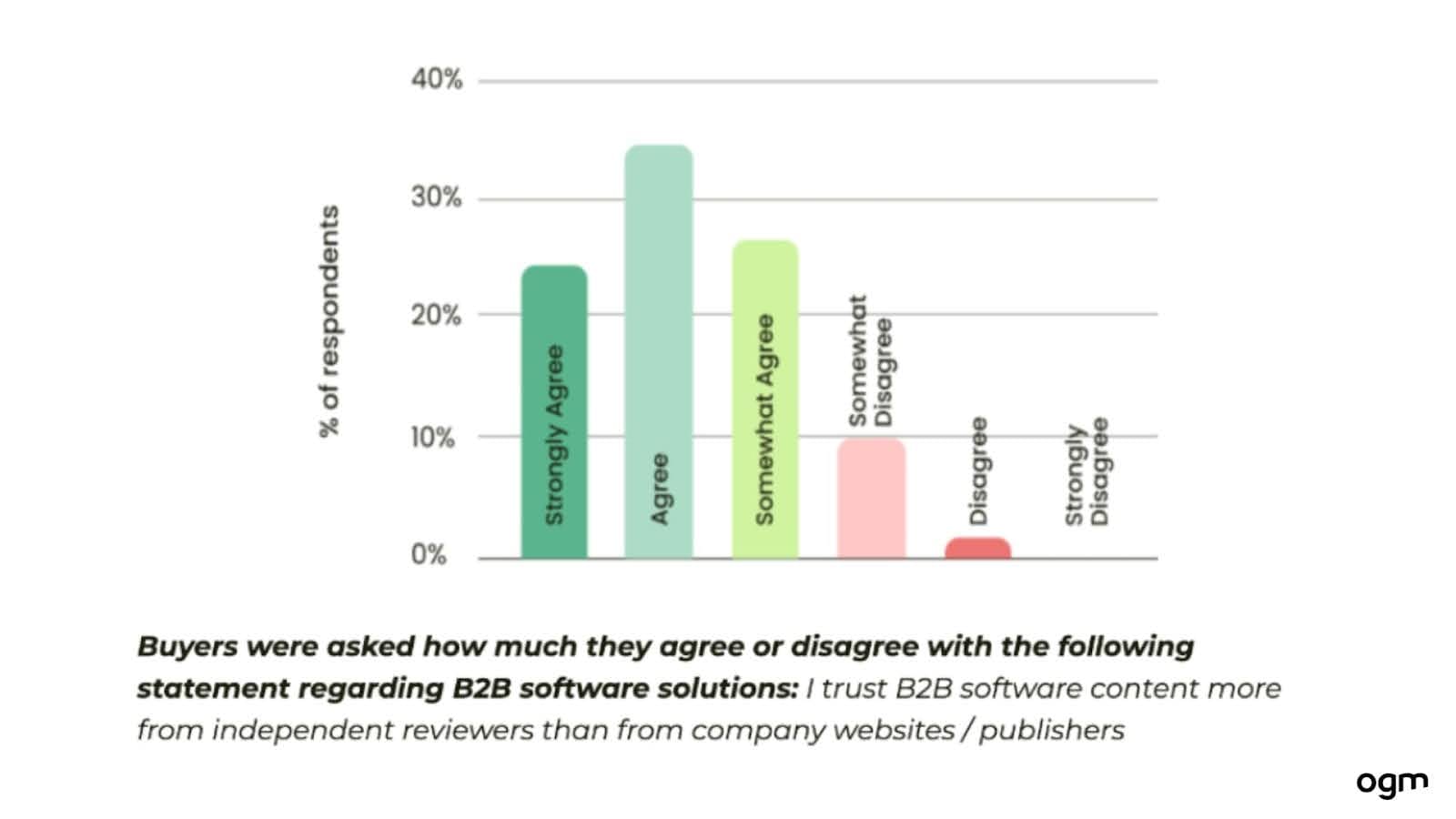
“Those search terms and queries that they're adding, those addendums, are sort of a signal of ‘I don't actually trust or I don't want at least the default results that I know Google is going to give me,” John says
We have to agree.
Especially when you consider that company content is the least trusted source by buyers. Instead, buyers now are relying on multiple sources when evaluating purchases, trusting offsite and third-party content the most while viewing most company-produced content as unremarkable and samey.
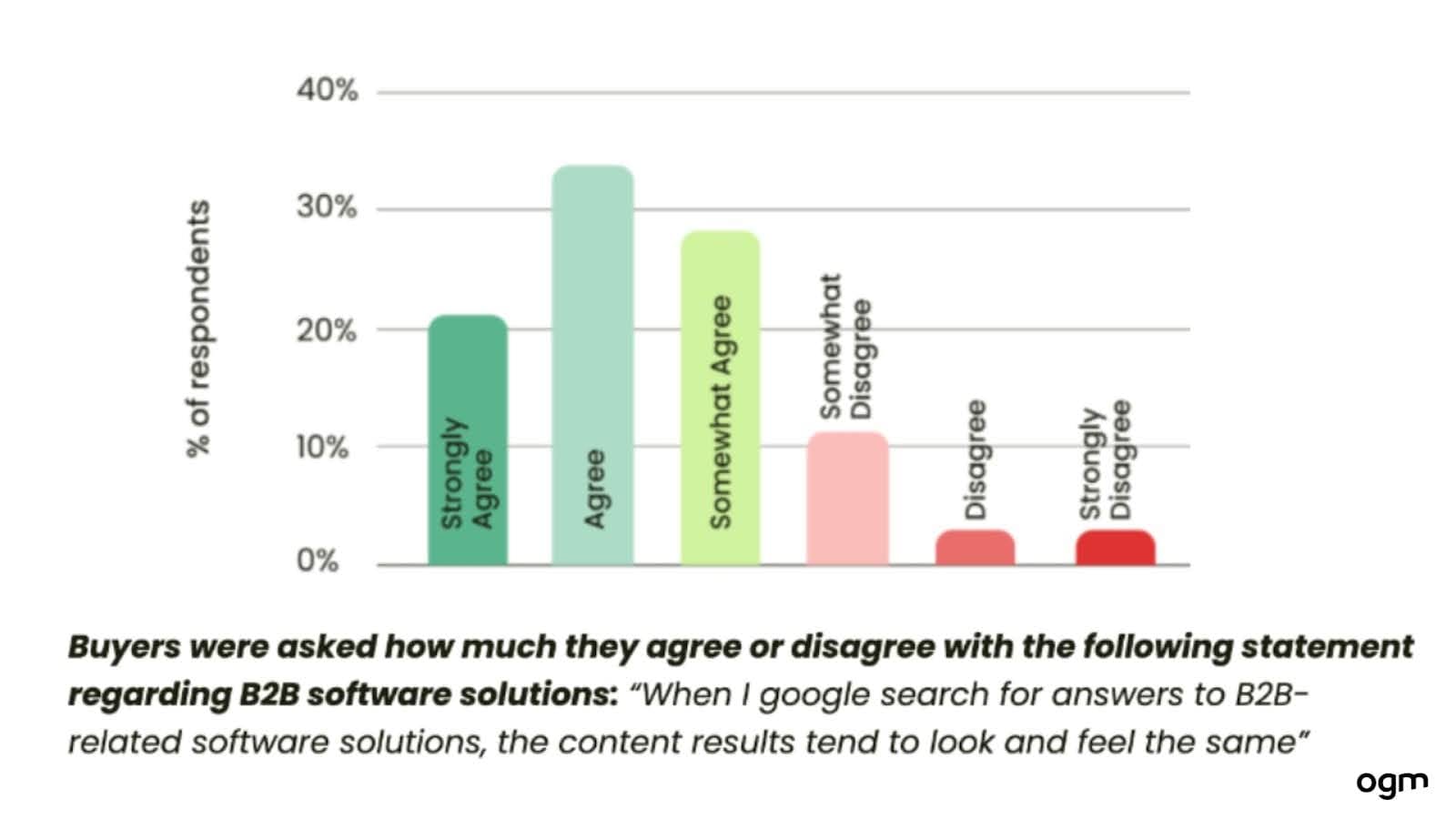
So, what can content marketers do with this knowledge?
According to John: focus on your content’s quality, not quantity.
“I think in most cases it's not about a high volume content strategy anymore,” he says. “We did that back in the day at Intercom. We published five times a week at one point. But we've seen the returns by increasing our publishing schedule. I think that's really hard to see right now. There's just so much content out there and there's so much, let's face it, low quality content.”
2. B2B brands must get opinionated
If buyers are having a hard time distinguishing between company-created content, is there an opportunity for more opinionated brand content to take over the SEO-sphere?
John Collins believes so.
“You can see what Google's trying to do with helpful content updates and things like that: they’re penalizing that playbook and trying to figure out the sites are actually adding value,” he says. “And I think particularly for startups, you want to try and stand out from the crowd. The benefit of that is that it's not just a pure SEO play. It builds your brand as well and it’s more likely to generate qualified traffic from people who are genuinely in the market for your solution.”
To add value and weight to your opinions, John recommends publishing data-driven content. And if you’re publishing original data, that’s a great backlink driver, too.
Another avenue for producing high-quality, opinionated content is by leveraging your own in-house subject matter experts. Here at Kapwing, our CEO and co-founder, Julia Enthoven, is heavily involved in content creation.
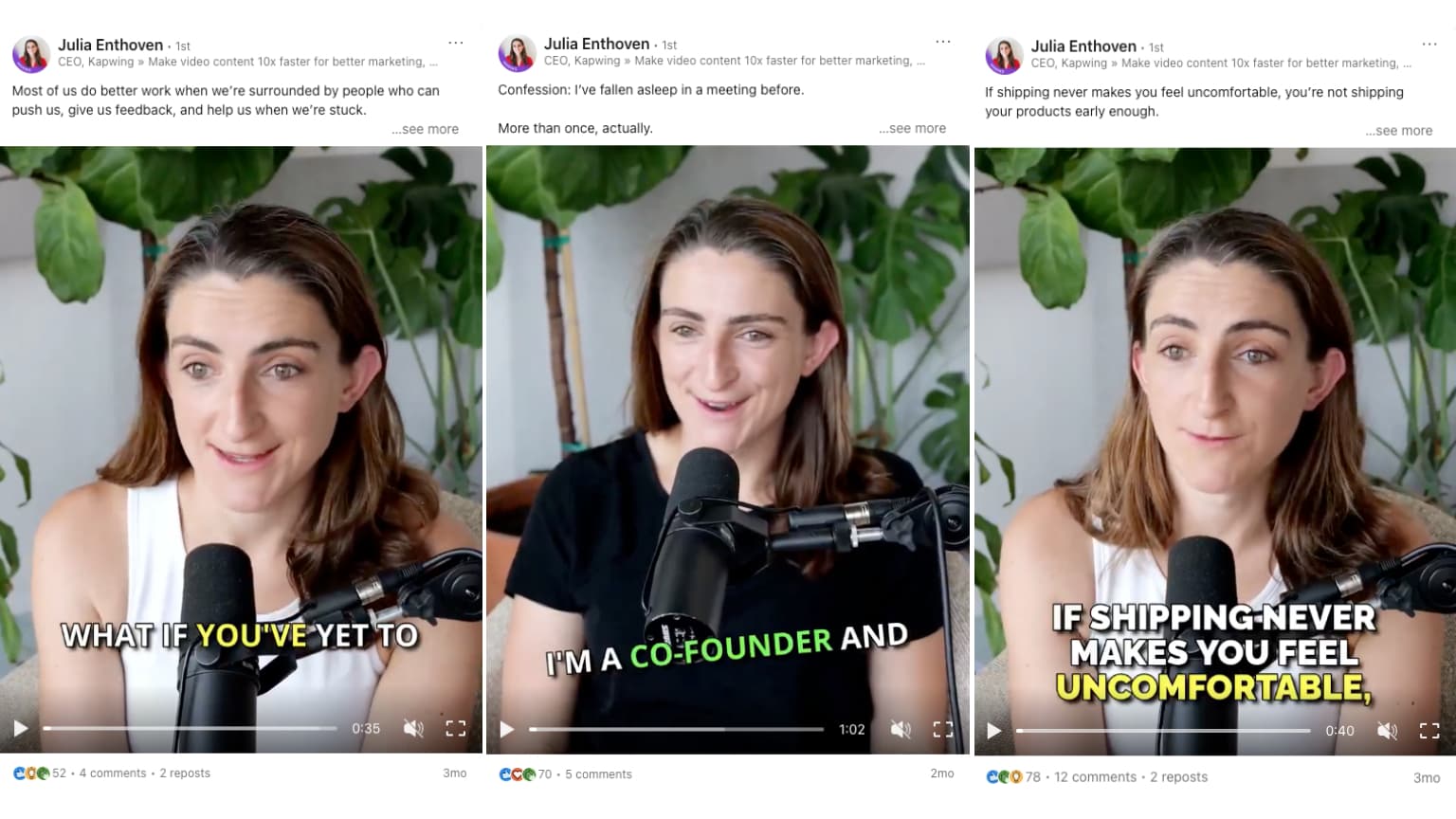
She publishes on the company blog as well as on her own personal LinkedIn, giving extra authority and reach to thought leadership topics the marketing team is distributing elsewhere.
The C-suite isn’t the only place you can look for subject matter experts, though. During his tenure at Intercom, John Collins regularly amplified the voices of internal subject matter experts, across multiple departments.
“The only time you would see content marketers’ bylines on the blog was if we were talking about the content team, sharing our experience,” he says. “With video, it’s different. Obviously not everyone’s going to be comfortable getting in front of a camera and you can’t turn everyone at the company into a personality. Figuring out how to get that subject matter expertise and depth into the content is really the key thing.”
Consistently publishing opinionated, authored content like that can help your company stand out from a sea of AI-generated content. Speaking of which…
3. It’s time to think about your AI strategy
When using it themselves to research B2B software, many buyers rank ChatGPT and AI tools highly in terms of trustworthiness—higher than they rank company-produced content. In fact, 36% agreed that ChatGPT has mostly replaced Google when they’re looking for answers about B2B software.
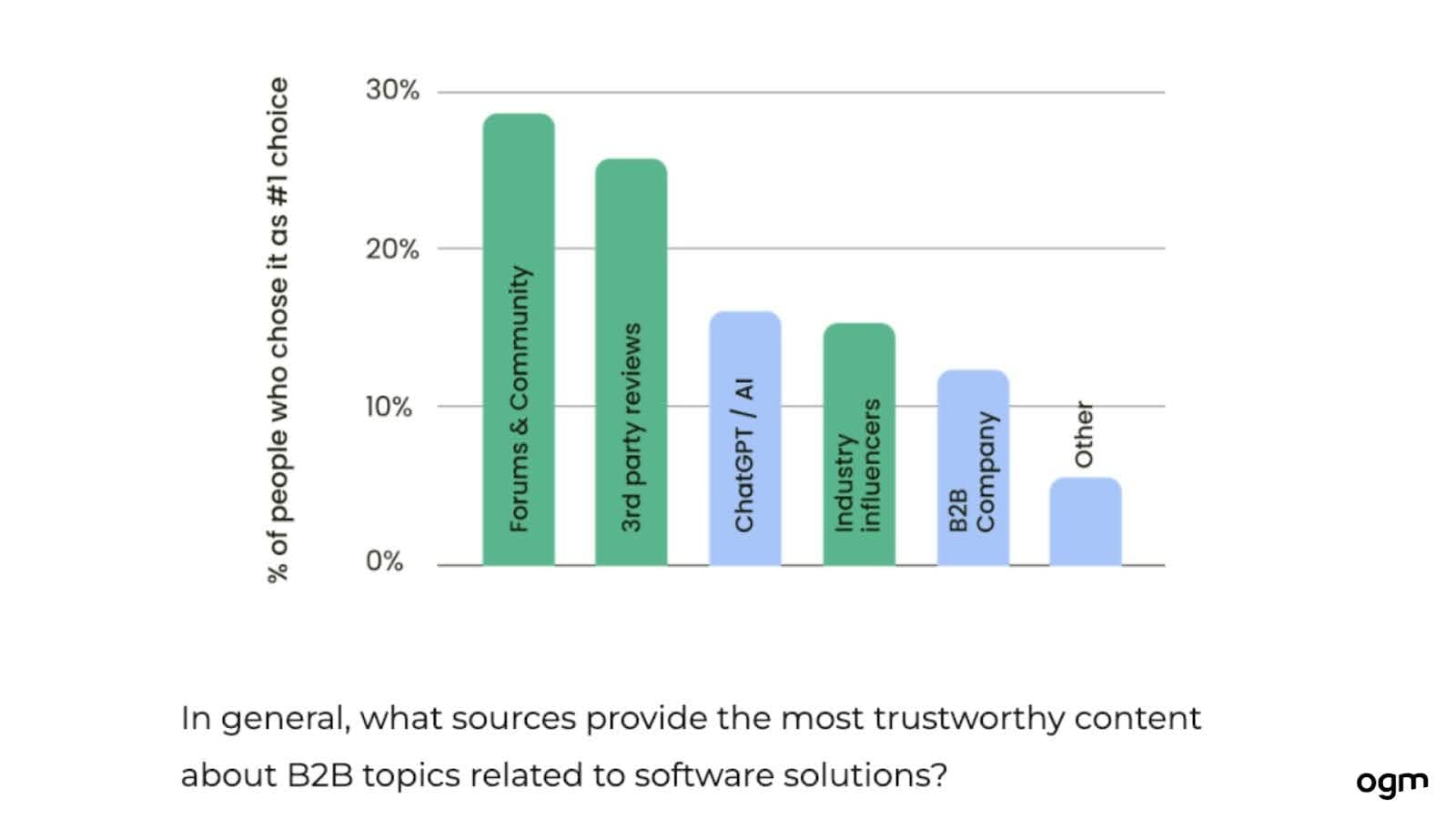
But this trust seems to fall apart if companies make AI-generated content.
“I think it's clear you've got to have an AI strategy,” John Collins says. “There's two things to think about: How are we using AI to help us create content? And how are we creating content that will get sucked into those large language models and help us be found?”
While AI can certainly be a useful tool for ramping up content production, if you’re not careful, AI content can also result in lost traffic if it’s thin, unhelpful, or otherwise low-quality. We also know that obviously AI-produced content is viewed as less trustworthy by users.
To combat these issues, John recommends only leveraging specialist tools for your marketing content efforts.
“Something very general, like ChatGPT, will produce your content for you,” he says. “But it’s a very broad brush tool. There are tools that are specifically designed, like Jasper for marketing teams or tools like Writer.”
Regardless of which AI writing tool you use, he recommends always having a human editor review and add back in the authentic opinions and flair that will help your content stand out.
The other piece, how to show up in AI search results, is more of a space to watch.
Previously, tools like ChatGPT could only return results based on the existing data set they’d been trained on. Now, though, with GPT-4 and Google Bard having real-time access to the internet, we’re seeing what AI-powered search can look like.
“I think increasingly that the future of SEO and content may not even result in a visit to your site,” John says. “It could just be content showing up in a chatbot attached to a large language model. And that may be all you need.”
AI search is still an evolving part of the SEO landscape, so any AI SEO strategy will require plenty of trial and error. But a good place to start is existing SEO best practices: keeping your technical, onsite SEO in great shape and producing high quality, original content that matches search intent and delivers value.
4. Video is an increasingly important part of the buyer journey
The data from John and the OGM team shows that 66% of buyers find short-form video (or video clips) to be more engaging than text articles.
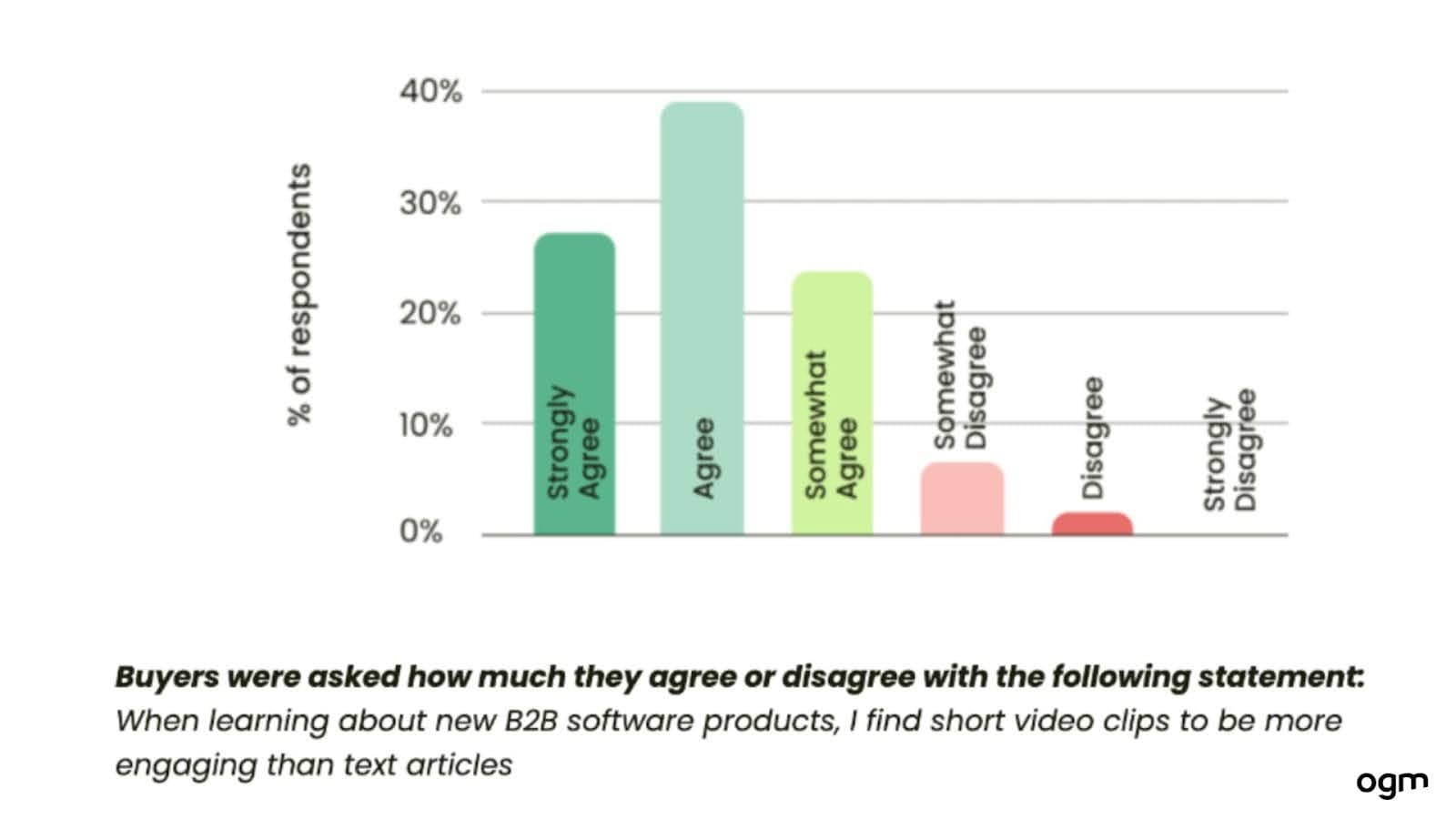
This echoes other data we’ve seen and is in keeping with the continuing trend of video’s popularity across marketing use cases. An especially useful distinction that comes out of this report, though, is where in the journey buyers prefer these formats.
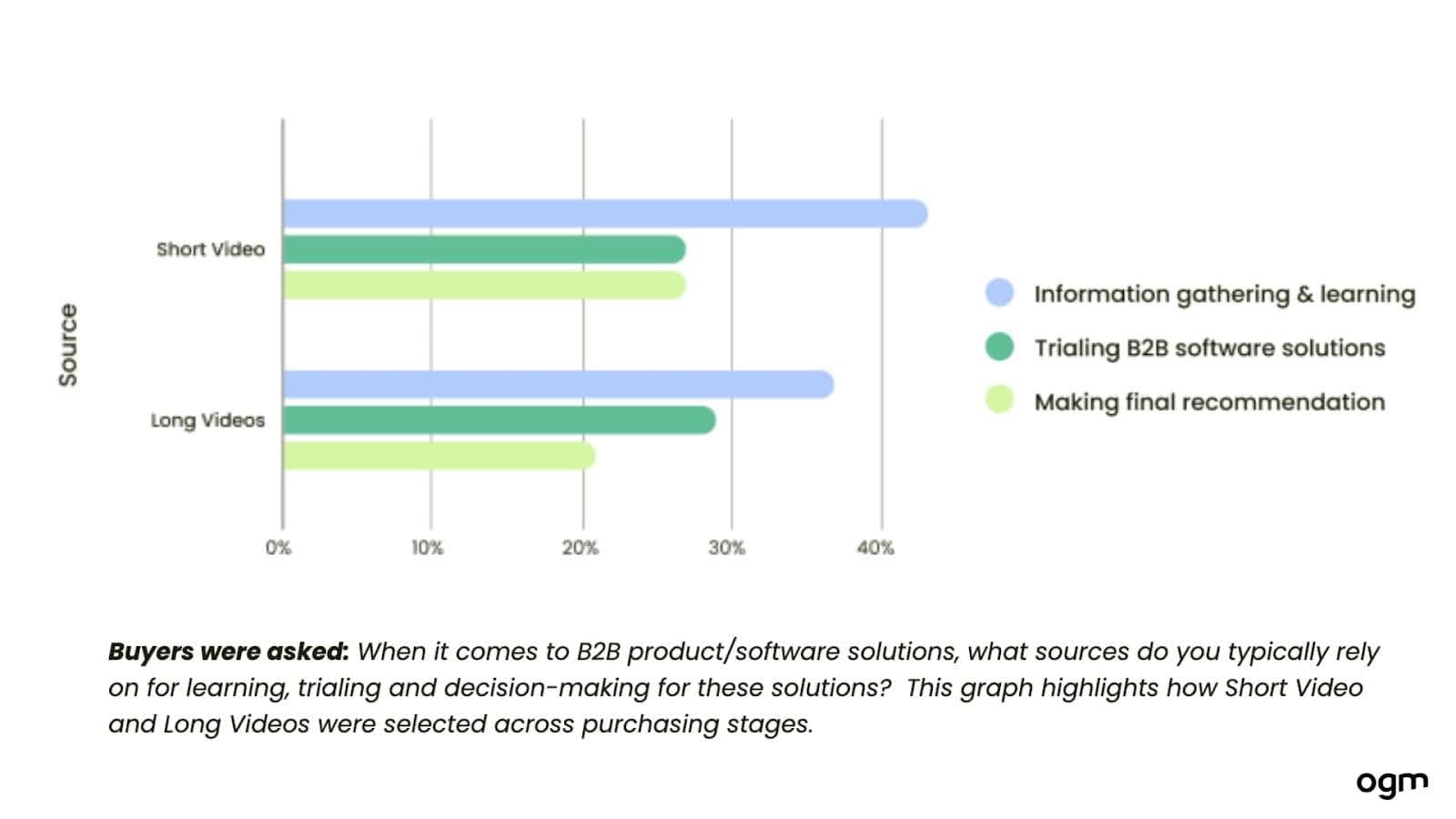
Short-form video is third (after search/company website) for information gathering, while long-form video is second (after free trials) for trialing software. Either way you slice it, video has to be a solid part of your content strategy to help nudge those prospects along in their buying decisions.
“It kind of goes back to what we heard in other parts of the survey,” Johns shares. “Which is that people just kind of want to get away from the fluff. They want to get a clear understanding of what your product does, what your offering is, and where you add value. Very direct, no-frills video [works well].”
This is particularly true for product launches.
Video is a much more succinct, engaging medium for showing off features. It also has the added benefit of extra reach across multiple platforms. You can publish a product announcement video to your YouTube channel, embed it as the hero video on a product landing page, and make clips to share it out across different social media channels.
📚 Learn more: How to Use YouTube for B2B Marketing
5. Podcasts are a brand-building medium
The survey data says podcasts are solidly a brand-building activity—not a conversion tool. Buyers say that podcasts don’t play a major role in their evaluation of software purchases. 34% of respondents cited podcasts as a source for the information gathering stage but only 17% say they refer to podcasts for trialing and final recommendations.
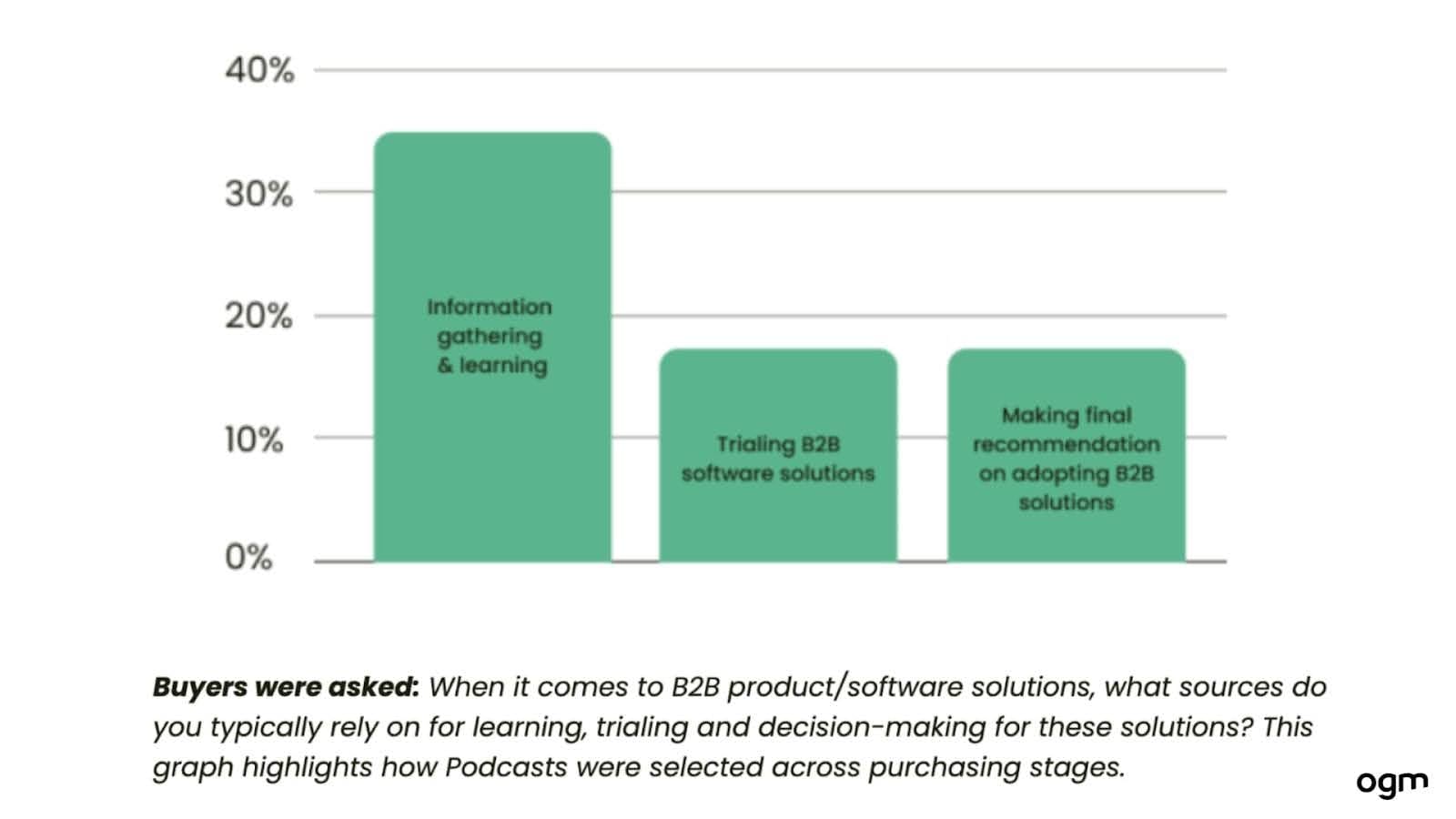
This is interesting data, given the prevailing opinion in marketing spaces that podcasts, and specifically video podcasts, are a great anchor medium (or a team’s primary content format) for B2B. Maybe more so than blogging.
How do we reconcile that with podcasts’ apparent lack of influence over purchasing decisions?
Lean in to their brand-building nature instead.
“I think there's still a lot of life in podcasts,” John says, “But it's gotten way more competitive. You’ve got to know, how are you going to stand out from the crowd?”
One way he recommends is by leveraging the built-in distribution power of video podcasts. Since podcasts are a brand-building tool anyway, you need to be maximizing your show’s exposure as much as possible. Having a solid clip strategy to distribute your show across multiple channels is a great way to do that.
While there’s plenty left to unpack from the report John Collins and OGM published, the main takeaway seems to be that focusing on content quality and authenticity—for both video and written content—should remain the North Star for B2B content marketing teams in the coming year.
Watch this episode of The Shortcut, featuring John Collins, to catch our whole interview with him where he shares even more of his insights.









